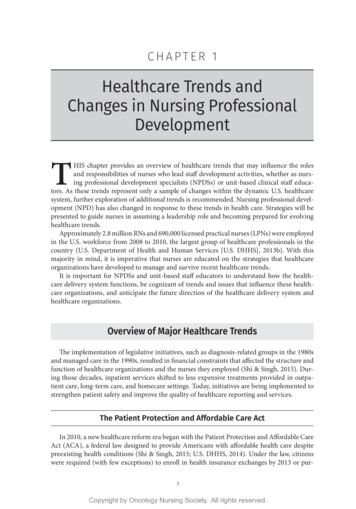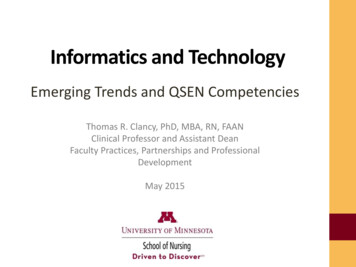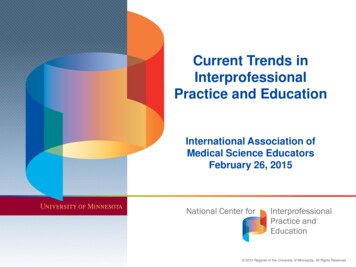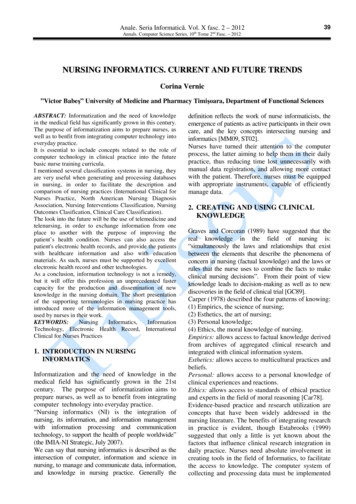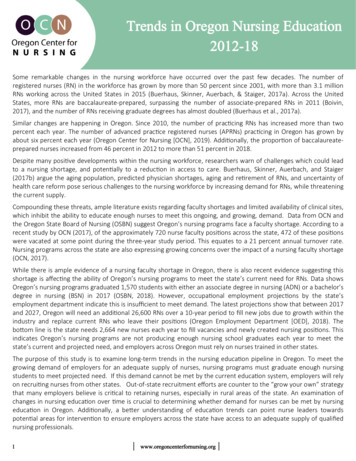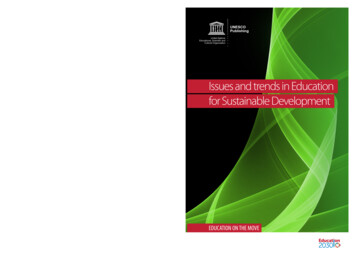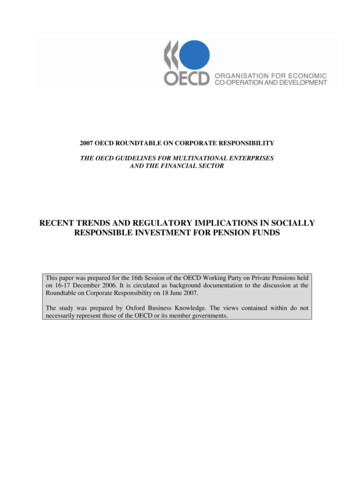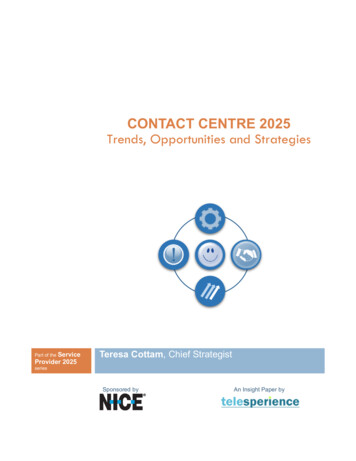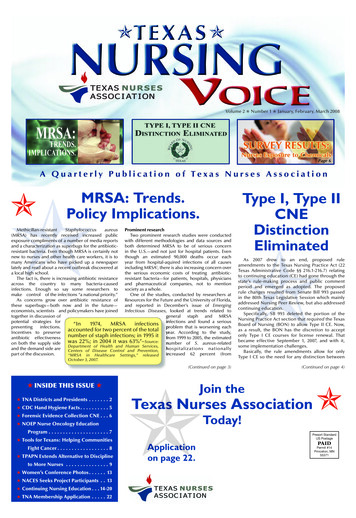
Transcription
Volume 2 Number 1 January, February, March 2008Page 6MRSA: Trends.Policy reusProminent research(MRSA) has recently received increased publicTwo prominent research studies were conductedexposure compliments of a number of media reportswith different methodologies and data sources andand a characterization as superbugs for the antibiotic- both determined MRSA to be of serious concernresistant bacteria. Even though MRSA is certainly not in the U.S.—and not just for hospital patients. Evennew to nurses and other health care workers, it is to though an estimated 90,000 deaths occur eachmany Americans who have picked up a newspaperyear from hospital-aquired infections of all causeslately and read about a recent outbreak discovered at including MRSA1, there is also increasing concern overa local high school.the serious economic costs of treating antibioticThe fact is, there is increasing antibiotic resistance resistant bacteria—for patients, hospitals, physiciansacross the country to many bacteria-causedand pharmaceutical companies, not to mentioninfections. Enough so say some researchers tosociety as a whole.make control of the infections “a national priority.”One of the studies, conducted by researchers atAs concerns grow over antibiotic resistance of Resources for the Future and the University of Florida,these superbugs—both now and in the future—and reported in December’s issue of Emergingeconomists, scientists and policymakers have joinedInfectious Diseases, looked at trends related totogether in discussion ofgeneral staph and MRSAgpotential strategies forinfections and found a serious“In1974,MRSAinfections inpreventinginfections.problem that is worsening eachpaccounted for two percent of the total yeIncentives to preserveyear. According to the study,number of staph infections; in 1995 it frantibiotic effectivenessfrom 1999 to 2005, the estimatedwas 22%; in 2004 it was 63%”–Source: non both the supply sidenumber of S. aureus-relatedDepartment of Health and Human Services,and the demand side arehospitalizations nationallyhCenters of Disease Control and Prevention,part of the discussion.increased 62 percent (fromin“MRSA in Healthcare Settings,” releasedOctober 3, 2007.Type I, Type IICNEDistinctionEliminatedAs 2007 drew to an end, proposed ruleamendments to the Texas Nursing Practice Act (22Texas Administrative Code §§ 216.1-216.7) relatingto continuing education (CE) had gone through thestate’s rule-making process and public commentperiod and emerged as adopted. The proposedrule changes resulted from Senate Bill 993 passedin the 80th Texas Legislative Session which mainlyaddressed Nursing Peer Review, but also addressedcontinuing education.Specifically, SB 993 deleted the portion of theNursing Practice Act section that required the TexasBoard of Nursing (BON) to allow Type II CE. Now,as a result, the BON has the discretion to acceptonly Type I CE courses for license renewal. Thatbecame effective September 1, 2007, and with it,some implementation challenges.Basically, the rule amendments allow for onlyType I CE so the need for any distinction between(Continued on page 3) INSIDE THIS ISSUE TNA Districts and Presidents . . . . . . . 2 CDC Hand Hygiene Facts . . . . . . . . . . 5 Forensic Evidence Collection CNE . . . 6Join theTexasas Nurses AssociationToday! NOEP Nurse Oncology EducationProgram . . . . . . . . . . . . . . . . . . . . . 7Presort StandardUS Postage Tools for Texans: Helping CommunitiesFight Cancer . . . . . . . . . . . . . . . . . . 8 TPAPN Extends Alternative to Disciplineto More Nurses . . . . . . . . . . . . . . . 9 Women’s Conference Photos . . . . . . 13 NACES Seeks Project Participants . . 13 Continuing Nursing Education . . . 14-20 TNA Membership Application . . . . . 22(Continued on page 4)ApplicatioApplicationon page 22.2PAIDPermit #14Princeton, MN55371
Page 2—Texas Nursing Voice—January, February, March 2008TNA Districts andPresidents1:2:3:4:5:6:7:Patty Shanaberger,r El PasoPhone:one: 915/490-6837Email: patricias@epcc.eduatricias@epcc.edupPaula AntognAntognoli, AmarilloPhone:e: antoc.commSandindi MMcDermott, Fort WorthrthPhone: 214/820-9651Email:sandim@baylorhealth.eduDistrict 3 Address:Renee James, PO Box 16958,Ft. Worth, TX 76162.Office: 817/249-5071;Email: tna3@usapathway.comWeb site: www.tna3.orgColleen Hines, DallasPhone: 972/348-1614Email: cmhteh@sbcglobal.netDistrict 4 Address: Pat Pollock,PO Box 35503, Dallas, 75235.Office: 972/435-2216,Email: d4tna@flash.netWeb site: www.tnad4.orgDeanna Eichler, AustinPhone: 361/324-7900Email: deichler@seton.orgDistrict 5 Web site:www.tna5.orgEllarene Duis, GalvestonPhone: 409/772-8390Email: erduis@utmb.eduDistrict 6 Web site:www.tna6.orgJoanne Gelsthorpe,Harker HeightsPhone: 254/690-8881Email: jgelsthorpe@hot.rr.com8: Gayle Dasher, San AntonioPhone: 210/705-6266Email: gdasher@satx.rr.comDistrict 8 Web site:www.texasnurses.org/districts/08/9: Lucindra Campbell,Missouri CityPhone: 281/649-3000 ext 2492Email: lcampbell@hbu.edu.District 9 Office:Melanie Truong,2370 Rice Blvd. #109,Houston, 77005.Office: 713/523-3619,Email: tna9@tnadistrict9.orgDistrict 9 Web site:www.tnadistrict9.org10: Barbara Hills, WacoPhone: 254/420-1231Email: bahills@grandecom.net11: Connie Beddingfield,Wichita FallsPhone: 940/521-5406Email:cbeddingfield@grahamrmc.com12: Patricia Morrell, BeaumontPhone: 936/212-7222Email: patricia.morrell@mhbh.org13: Vacant14: Joe Lacher, BrownsvillePhone: 956/882-5072Email: joe.lacher@utb.edu15: Andrea Kerley, AbilenePhone: 325/670-4230Email: akerley@hendrickhealth.orgDistrict 15 Web site:www.texasnurses.org/districts/15/16: Martha Sleutel, San AngeloPhone: 325/949-3699Email: martha.sleutel@angelo.edu17: Nancy Goodman,Corpus ChristiPhone: 361/825-2607Email:nancy.goodman@tamucc.eduDistrict 17 Web site:www.texasnurses.org/districts/17/18: Patty Freier, LubbockPhone: 806/797-8120Email: pfreier@covhs.orgDistrict 18 Web site:www.texasnurses.org/districts/18/19: Kleanthe Caruso, TylerPhone: t 19 Web site:www.texasnurses.org/districts/19/20: Kathleen Elliott, Port LavacaPhone: 361/552-3063Email: stormybill@yahoo.com21: Sherrie Harris, OdessaPhone: 432/381-2429Email: sherre@clearwire.net22: Toni McDonald, CrockettEmail: mitchm@consolidated.net25: Shirley Aycock, LongviewPhone: 903/646-3745Email: sapaycock@hotmail.com26: Carolina Huerta, EdinburgPhone: 956/383-7365Email: chuerta@panam.edu28: Patsy Cornelius, TexarkanaPhone: 903/832-5565 ext. 3301Email: pcorneli@texarkana.edu29: Sally Durand, AlvinPhone: 281/756-3634Email: sdurand@alvincollege.eduTEXAS NURSING VoiceJanuary - February - March 2008Volume 2, Number 1Editor-in-Chief—Clair B. Jordan, MSN, RNManaging Editor—Joyce CunninghamCreative Communications—Deborah TaylorCirculation Manager—Belinda RicheyEditorial contributorsAnita J. Coyle, PhD, RN, CHES; Joyce Cunningham;Vernell DeWitty, PhD, MBA, MSN, RN;Laura Lerma, MSN, RN; Aileen Kishi, PhD, RN;Diane E. Scott, MSN, RN;Michael Van Doren, MSN, RN, CARNExecutive OfficersSusan Sportsman, PhD, RN, TNA PresidentMargie Dorman-O’Donnell, MSN, RN, TNA Vice PresidentRebecca Krepper, PhD, MBA, CNAA, TNA SecretaryTreasurerRegional Directors of Texas Nurses AssociationNorth Region—Kleanthe Caruso, MSN, RN, CNAA, CCHPSouth Region—Jennifer D.M. Cook, PhD, MBA, RNCentral Region—Dana Danaher, MSN, RN, CPHQEast Region—Viola Hebert, MA, BSN, RNWest Region—Jo Rake, MSN, RNTEXAS NURSING Voice is published quarterly—October-November-December, January-FebruaryMarch, April-May-June, and July-August-September—by Texas Nurses Association, 7600 Burnet Road,Suite 440, Austin, TX 78757-1292.Editorial Office: TEXAS NURSING Voice,7600 Burnet Road, Suite 440, Austin, TX 78757-1292512.452-0645, E-mail: tnveditorial@texasnurses.orgAddress changes:Send address changes to Texas Nurses Association,7600 Burnet Road, Suite 440, Austin, TX 78757-1292E-mail: tnvcirculation@texasnurses.orgAdvertising:Arthur L. Davis Agency, 517 Washington St.P.O. Box 216, Cedar Falls, Iowa 50613319.277-2414, E-mail: sales@aldpub.comTexas Nurses Association and the Arthur L. DavisAgency reserve the right to reject any advertisement.Responsibility for errors in advertising is limited tocorrections in the next issue or refund of price ofadvertisement.Acceptance of advertising does not implyendorsement or approval by Texas Nurses Association(TNA) of products advertised, the advertisers, or theclaims made. Rejection of an advertisement does notimply a product offered for advertising is withoutmerit, or that the manufacturer lacks integrity, or thatthis association disapproves of the product or its use.TNA and the Arthur L. Davis Publishing Agency shallnot be held liable for any consequences resulting frompurchase or use of an advertiser’s product. Articlesappearing in this publication express the opinions ofthe authors; they do not necessarily reflect the viewsof the staff, board, or membership of TNA or those ofthe national or local associations.Copyright 2008 by Texas Nurses Association.
January, February, March 2008—Texas Nursing Voice—Page 3Trends: Implications of MRSA(Continued from page 1)294,570 to 477,927) and the MRSA-related hospitalizations estimated nationally forthe same time period more than doubled (from 127,036 to 278,203).1The second study conducted by the Centers for Disease Control andPrevention (CDC) researchers was published in early 2007 in the Journal of theAmerican Medical Association (JAMA) and looked at MRSA cases in 2005. It toosuggested that S. aureus and MRSA be considered “a national priority for diseasecontrol.”1. National surveillance or reporting requirements for the infections.2. More research to explore the interaction between community- and hospitalassociated infection.3. Increased efforts to control hospital infection.4. Increased investment in the development of staph vaccine. Reporting—in 2003, Illinois became the first state to require hospitals to includeHAI (hospital-associated infection) rates in quarterly reports to its Departmentof Public Health. Since then, half of the United States has enacted some kindof legislation that requires hospitals to report HAI-related rates in some way.Extending the Cure project notes some states focus their requirements onEconomics of the problemprocess—reporting of measures taken to reduce transmission of infection.Infections with S. aureus are difficult to treat; S. aureus infections resistant toOther states focus on outcomes—the number of actual HAIs in hospitals.methicillin even more so. “By the late 1960s, 80% of community- and hospitalIn 2007, the Texas Legislature passed legislation requiring certain health careacquired S. aureus isolates were resistant to penicillin”1 which had only beenfacilities to disclose patient infection rates to the public. The legislation, initiatedintroduced into medical practice in the 1940s. MRSA appears to be following thewith the filing of Senate Bill 288 by Sen. Jane Nelson, R-Lewisville, (Housesame pattern. Besides patient suffering, required hospital stays are longer, use ofsponsor, D. Delisi, R-Temple) requires health care facilities to submit infection datadrugs has increased—including vancomycin, often used when all others fail—andquarterly to the Texas Department of State Health Services (DSHS). Then usingthe need for isolation strategies promoted for MRSA-positive patients.that information, DSHS is required to compile annual reports providing details ofSeveral studies have estimated antimicrobial drug-resistant infections increaseinfection rates. Gov. Rick Perry signed the legislation into law on June 15.death, illness and directs costs by 30 to 100 per cent.2 TreatingIn reporting HAI-related rates, it is hoped that the probleman antibiotic-resistant staff infection vs. an antibiotic-sensitiveoof infections can be quantified and trends tracked. Only“By using antibiotics today,infection increases from 3000 to more than 35,000 a casesseven states have no legislation to date and no formal actions1we may inadvertentlyor as suggested in the Emerging Infectious Diseases article ,ttaken: Montana, Wyoming, Utah, Arizona, North Dakota,“MRSA cost the healthcare system (patients and hospitals) anencourage resistance andSSouth Dakota, and Maine.extra 830 million- 9.7 billion in 2005, even without taking intothereby limit our ability toaccount indirect costs related to patient pain, illness, and time Communityandhospital-associatedinfectionuse them tomorrow.”spent in the hospital.”iinteraction—CDC researchers found “community-associatedAccording to the Resources for the Future study,MMRSA is spreading more rapidly and possibly making itsresearchers found “dramatic increases were observed in the incidence of skinway into hospitals.”hospitals As reported in JAMA, the CDC researchers were ableand soft tissue infections that are typically community associated.” And no trendto determine that most of the community-associated patients had beenexisted for the number of deaths “from hospital-associated staph or MRSAhospitalized or in other health care settings which explained the potentialinfections.”source of the bacteria. Still, “about 14 per cent of invasive MRSA cases seemNoted senior study author Ramanan Laxminarayan, PhD, MPH, in a publishedto have become infected in the community, outside of any healthcare setting,”statement, “Antibiotic-resistant infections are spreading more rapidly in therevealed the CDC researchers.community while the epidemic of drug-resistant infections in hospitals continuesDramatic increases in patients hospitalized due to the incidence of skin andunabated.” Dr. Laxminarayan is co-author of Extending the Cure—Policysoft-tissue infections (mainly non-invasive) have been observed and according toResponses to the Growing Threat of Antibiotic Resistance—a report of theExtending the Cure researchers, “nearly tripled between 1999 and 2005.”Resources for the Future research project funded by the Robert Wood JohnsonFoundation’s Pioneer Portfolio and published in March 2007 that frames the Controlling hospital infections—improving infection control would certainlygrowing problem of antibiotic resistance and outlines policy strategies forlessen the need for some antibiotics, and reduce transmission within a hospitaladdressing it. The report examines incentives-based policies aimed at reducingsetting. Handwashing practices remain the leading intervention for spreadingdemand and increasing supply that would protect antibiotic effectiveness;nosocomial infections in health care facilities and should be encouraged.much like an approach of preserving shared natural resources that overuse canIsolation of patients with a colonized infection and standard, contactultimately deplete.precautions such as gloves or gowns and gloves should be implemented.Researcher suggestionsTo address the spread of both staph and MRSA infections, the Resources forthe Future researchers offer suggestions for preserving antibiotic effectivenessthrough incentive-based policies:3 Investing in development of staph vaccine—the researchers considered, “canvaccines reduce antibiotic use?“ Certainly vaccinations can lower the incidenceof infections and therefore the need to treat them. However, a vaccine to(Continued on page 4)
Page 4—Texas Nursing Voice—January, February, March 2008Trends: Implications of MRSA(Continued from page 3)prevent MRSA infections is not yet available.Researchers noted that federal support of researchon MRSA vaccine could expedite its development.Recommendations for policyThe incentive-based solutions for demand-side andsupply-side options presented in the Extending theCure report were according to the authors “startingpoints for discussion.” If on the demand side, reducingantibiotic prescribing through education of patientsand physicians about the risks of greater antibioticuse, and reducing the need for the antibiotics throughvaccinations and infectioncontrol in hospitals isn’teffective; and on the supplyAntibioticside, encouraging newresistantantibiotics and reducingbacteria areincentivestooversella naturalexisting ones isn’t effectiveeither, researchers suggestconsequencefiguring out “who ownsof antibioticantibiotic effectiveness.”use.Like clean air, oil, fishandforests,antibioticeffectiveness is a sharednatural resource, Extending the Cure researcherssuggest. As with any natural resource, overusedepletes it and in the case of antibiotics, overuseuses up their effectiveness as a future treatment byincreasing bacterial resistance. If it is in the nationalinterest to preserve antibiotic effectiveness forthe population as a whole, say the researchers, itcould take government intervention and federalstewardship. References1. Klein, E., D.L. Smith, R. Laxminarayan (2007).“Hospitalizations and Deaths Caused by MethicillinResistant Staphylococcus aureus, United States, 1999-2005.”Emerging Infectious Diseases 113: 1840-1846.2. Cosgrove, SE, Carmeli Y, The impact of antimicrobialresistance on health and economic outcomes. Clin InfectDis 2003;36:1433-7.3. New Study: Hospitalizations Related to SuperbugInfections Double Over Six year (November 29, 2007).Retrieved December 31, 2007 from p?productid 23971&typeid 1604. Klevens, R.M., J.R. Edwards, et al. (2007). “EstimatingHealth Care-Associated Infections and Deaths in U.S.Hospitals, 2002.” Public Health Reports 160: 160-166.Type I, Type II CNE Distinction Eliminated(Continued from page 1)Type I and Type II has been eliminated. Withoutthat Type I vs. Type II discussion to contemplate,what remains is simply a focus on continuingnursing education, specifically what is acceptableCE and what is unacceptable CE?The answer can be found in amendments toSection 22 TAC §§ 216.4—Criteria for AcceptableContinuing Education Activity—of the NursingPractice Act:Continuing Education programs must beapproved by a credentialing agency or anaffiliated entity of one of these agencies. Proofof successful completion shall contain thename of the provider; the program title, date,and location; number of contact hours; providernumber; and credentialing agency.A few of the Board-approved credentialingagencies include American Nurses CredentialingCenter, American Academy of Nurse Practitioners,Licensed Vocational Nurses Association of Texas,and Continuing Medical Education (for APNs only).A full list of credentialing agencies can be obtainedfrom the BON or its Web site.Section 216.5 of the Nursing Practice Act—Additional Criteria for Specific ContinuingEducation Programs—speaks to the academiccourses. In addition to those programs reviewedby a Board-approved entity, a licensee may attendan academic course that is within the frameworkof curriculum that leads to an academic degree innursing or an academic course relevant to nursingpractice; will be able to present an official transcriptindicating completion of the course with a gradeof C or better, or a grade of passing in a pass/failgrading system.Combined Boards’ influenceIn 2004, the BON (then named the Board ofNurse Examiners) combined with the Board ofVocational Examiners to create a single nursingBoard in Texas. Before February 1, 2004, LVNs hadbeen required to have only Type I CE for licenserenewal. When the Boards combined, the NursingPractice Act allowed registered nurses to have TypeII CE, so the LVNs were then allowed to have up to10 hours of Type II CE.Texas Nurses Association Weighs InTaking advantage of the opportunity to commenton proposed rule amendments, Texas NursesAssociation expressed a concern to the BON that atransition period for reaching the new requirementsdid not seem to be provided in the proposed ruleamendments, and that a delayed implementationdate might be beneficial and less disruptive to allnurses trying to meet the new requirements. TNAproposed a target date of January 1, 201
Page 2—Texas Nursing Voice—January, February, March 2008 1: Patty Shanaberger, El Paso Phone: 915/490-6837 Email: patricias@epcc.edu 2: Paula Antognoli, Amari
